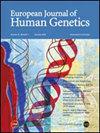在COL7A1启动子中削弱Sp1转录因子结合的新变异导致轻度隐性营养不良大疱性表皮松解症。
IF 3.7
2区 生物学
Q2 BIOCHEMISTRY & MOLECULAR BIOLOGY
引用次数: 0
摘要
隐性营养不良大疱性表皮松解症(RDEB)是一种罕见且最常见的严重遗传性皮肤病,其特征是轻微创伤后皮肤和粘膜复发性起泡和糜烂,导致严重的局部和全身并发症。RDEB是由编码VII型胶原(C7)的COL7A1的功能缺失突变引起的,C7是锚定原纤维的主要成分,形成稳定皮肤基底膜区的附着结构。大多数先前报道的COL7A1突变位于编码区或内含子区。我们描述了6例局部或中间RDEB患者,他们在编码区发现了一个隐性致病变异,在COL7A1启动子中发现了第二个变异。这些取代,其中三个是新发现的,定位于启动子区域的两个Sp1结合位点。DNA拉下分析显示Sp1结合的急剧减少与COL7A1转录物的急剧下降一致,几乎检测不到C7蛋白水平。我们的研究结果表明,null等位基因背景下COL7A1启动子的突变可能是局部或中间RDEB的基础。他们进一步强调了COL7A1近端启动子Sp1基序的功能重要性,对于编码区或内含子区仅鉴定出一种致病变异的RDEB,应该仔细研究其调控突变。本文章由计算机程序翻译,如有差异,请以英文原文为准。

Novel variants impairing Sp1 transcription factor binding in the COL7A1 promoter cause mild cases of recessive dystrophic epidermolysis bullosa
Recessive dystrophic epidermolysis bullosa (RDEB) is a rare and most often severe genodermatosis characterized by recurrent blistering and erosions of the skin and mucous membranes after minor trauma, leading to major local and systemic complications. RDEB is caused by loss-of-function mutations in COL7A1 encoding type VII collagen (C7), the main component of anchoring fibrils which form attachment structures stabilizing the cutaneous basement membrane zone. Most of the previously reported COL7A1 mutations are located in the coding or intronic regions. We describe 6 patients with localized or intermediate RDEB for whom one recessive pathogenic variant in the coding region and a second variant in the COL7A1 promoter were identified. These substitutions, three of which are novel, are localized in two Sp1 binding sites of the promoter region. DNA pull-down assay showed a drastic reduction of Sp1 binding consistent with a dramatic decrease in COL7A1 transcript and almost undetectable C7 protein levels. Our results reveal that mutations in the COL7A1 promoter on the background of a null allele can underlie localized or intermediate RDEB. They further emphasize the functional importance of Sp1 motifs in the proximal COL7A1 promoter which should be carefully investigated for regulatory mutations in the case of RDEB with only one pathogenic variant identified in the coding or intronic regions.
求助全文
通过发布文献求助,成功后即可免费获取论文全文。
去求助
来源期刊

European Journal of Human Genetics
生物-生化与分子生物学
CiteScore
9.90
自引率
5.80%
发文量
216
审稿时长
2 months
期刊介绍:
The European Journal of Human Genetics is the official journal of the European Society of Human Genetics, publishing high-quality, original research papers, short reports and reviews in the rapidly expanding field of human genetics and genomics. It covers molecular, clinical and cytogenetics, interfacing between advanced biomedical research and the clinician, and bridging the great diversity of facilities, resources and viewpoints in the genetics community.
Key areas include:
-Monogenic and multifactorial disorders
-Development and malformation
-Hereditary cancer
-Medical Genomics
-Gene mapping and functional studies
-Genotype-phenotype correlations
-Genetic variation and genome diversity
-Statistical and computational genetics
-Bioinformatics
-Advances in diagnostics
-Therapy and prevention
-Animal models
-Genetic services
-Community genetics
 求助内容:
求助内容: 应助结果提醒方式:
应助结果提醒方式:


